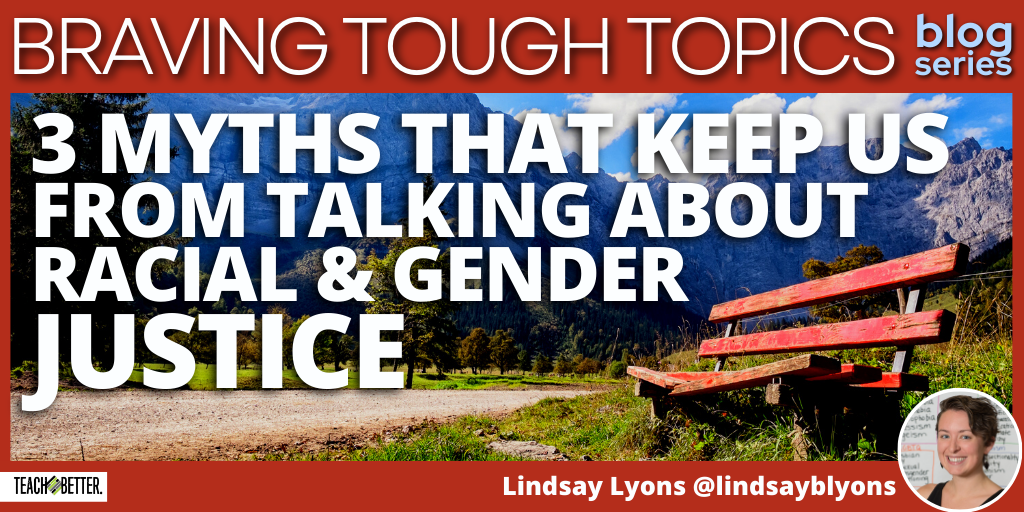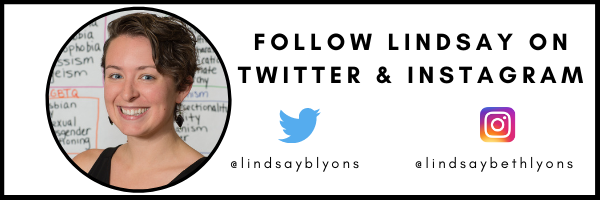TL;DR:
- Consider the 3 myths that keep us from talking about racial and gender justice in schools.
- It is important for all students to discuss racial and gender justice by acknowledging the impact and by taking action.
- There are opportunities to talk about racial and gender justice in younger grades and in various subject areas beyond Social Studies and Ethnic Studies classes.
- We must “hear all sides” and ensure that facts are accurate.
If you’ve been wanting to have conversations with staff and/or students about current events, politics, and social justice, but haven’t made the leap…this post is for you.
There are several reasons why we may shy away from talking about necessary, high-emotion topics. Some educators have to grapple with state laws that put their jobs at risk if they talk about racial and gender justice. Though, for many of us, the perceived risk is more emotional discomfort. This is challenging work, but if you’re reading this post, you also know it’s worth it.
Let’s tackle the three biggest myths I’ve seen come up in my work helping schools and districts develop and facilitate justice-centered cultures and curricula.
Myth #1: My students are white, cisgendered students so talking about racial and gender justice is less important for them.
White supremacy harms people who are racialized as Black, Brown, Asian, or any racial identifier other than white. It’s also harmful—of course, in a different way—for students who are racialized as white to participate in a system of dominance, oppression, and supremacy of some bodies over others. Resmaa Menakem, author of My Grandmother’s Hands, calls this impact on white bodies “soul harm.” We can acknowledge this to be true and simultaneously recognize the reality that Brown folx have experienced far more violence as a result of white supremacy than white folx.
The same logic applies to gender or any other oppressive system. Uncritically participating in a system that advantages us while disadvantaging others chips away at our humanity. Dr. Cherie Bridges Patrick has likened this to winning a race where you got a head start. You don’t feel good winning that race. You probably feel gross. Let’s help every student see these systems for what they are: dehumanizing to anyone involved. Then, we can connect students with opportunities to take action, dismantle these structures, and preserve their full humanity.
Take Action
Language matters, and it affects how we perceive these myths, which impacts the actions we take (or don’t take). For example, think about how we identify racial differences. White is a race. Let’s start naming it, rather than allowing whiteness to become invisible and thus perceived as normative. When describing a white person, name that their skin is white. When teaching U.S. History, use terms like “white enslavers” to focus on the actions and oppressive structures created by white people instead of using terms like “Black history” to refer to enslavement as if white people had nothing to do with it.
In my own classes, I’ve seen the deepest engagement, highest attendance rates, and greatest academic achievement when I center conversations about racial and gender justice. Students want to talk about things that matter. Click To TweetMyth #2: Talking about racial and gender justice is only for high school ELA, Social Studies, and “Ethnic Studies” teachers.
Talking about critical topics like current events is valuable for all students, regardless of age (though the approach will be different). It is relevant to all content areas. It is a critically important skill for leaders and non-teaching staff to be able to engage in and facilitate conversations about in/justice with staff and students.
Let’s take these contexts one at a time.
Young Children
A Kindergarten child asks their teacher what “My body my choice” means. The teacher can engage the class in conversation about consent (i.e., “We ask permission before touching others. We don’t touch people who don’t want to be touched”). That is an age-appropriate conversation for a Kindergarten class and is a throughline to a high school conversation about abortion access and reproductive justice. Conversations about racial and gender justice at this age will likely use language of “fairness” which is a concept that young kids understand.
Also, kids are not too young to talk about race. One study found 5-year-olds hold white supremacist attitudes, and that talking about race—for example, interracial friendship—can dramatically improve children’s racial attitudes in one week. (This popular infographic references these studies and more on young children’s perceptions and attitudes surrounding race.)
Math Content
From a first grade teacher teaching the skill of tallying by counting the number of U.S. senators by race and gender to a high school teacher teaching geometry and gerrymandering, math (and science and other non-ELA and history content areas) presents thoughtful opportunities to engage students in conversations about racial and gender justice.
School or District Leader
Staff are better able to facilitate conversations when they have practiced talking about the topic as a participant. As a leader, offer teachers professional development opportunities in which they can practice talking about current events, political topics, and community happenings that relate to racial and gender justice. Share strategies and resources that can help them do this in their classrooms as well, but time for practice is critically important. Model what facilitating conversations about justice can look like. Engage teachers in preparatory discussions of what to do if a student says “x.” Let them know you have their back if a family member does reach out with concerns.
[scroll down to keep reading]Myth # 3: We must “hear all sides.”
Jonathan Gold has written about this, saying, “Talking about perspectives without talking about power can imply an equivalency of viewpoints that brings with it a very real danger of erasing…injustice.” Of course, we don’t want any of our students to feel fearful of embarrassment or punishment for sharing their ideas. At the same time, we need to uphold dignity for all people. (This is an important foundational agreement set at the start of all of my classes whether I’m teaching children or adults.) The other piece to this is that as an educational institution, facts matter. If a student is repeating inaccurate information, we should correct it. There are a number of ways to do this. My favorite is a post-debate-style “Fact Checkers” lesson in which students get to research the accuracy of several student statements from the previous day’s discussion.
Theory to Practice
Scholars Diana Hess and Paula McAvoy encourage educators to distinguish between settled empirical “issues” (not debatable) and policy issues (debatable). Here’s what this could look like in a classroom: We ask students to share the best way to solve racial injustice, but we don’t debate the reality of racial injustice. This means we start by sharing (or having students research) factual information about the presence of systemic racism, and then focus “debate” or disagreement on how to eliminate structural racism.
In my own classes, I’ve seen the deepest engagement, highest attendance rates, and greatest academic achievement when I center conversations about racial and gender justice. Students want to talk about things that matter. They want to feel like they are capable of making the world better. As educators, I think we can all relate to that. This is challenging and necessary work. If you need support, I’m here for you!
To get you started, here’s the planning template I use for class circle conversations.
About Lindsay Lyons
Lindsay Lyons is an educational consultant who works with teachers and school leaders to inspire educational innovation for racial and gender justice, design curricula grounded in student voice, and build capacity for shared leadership. Lindsay taught in NYC public schools, holds a PhD in Leadership and Change, and is the founder of the educational blog and podcast, Time for Teachership.





